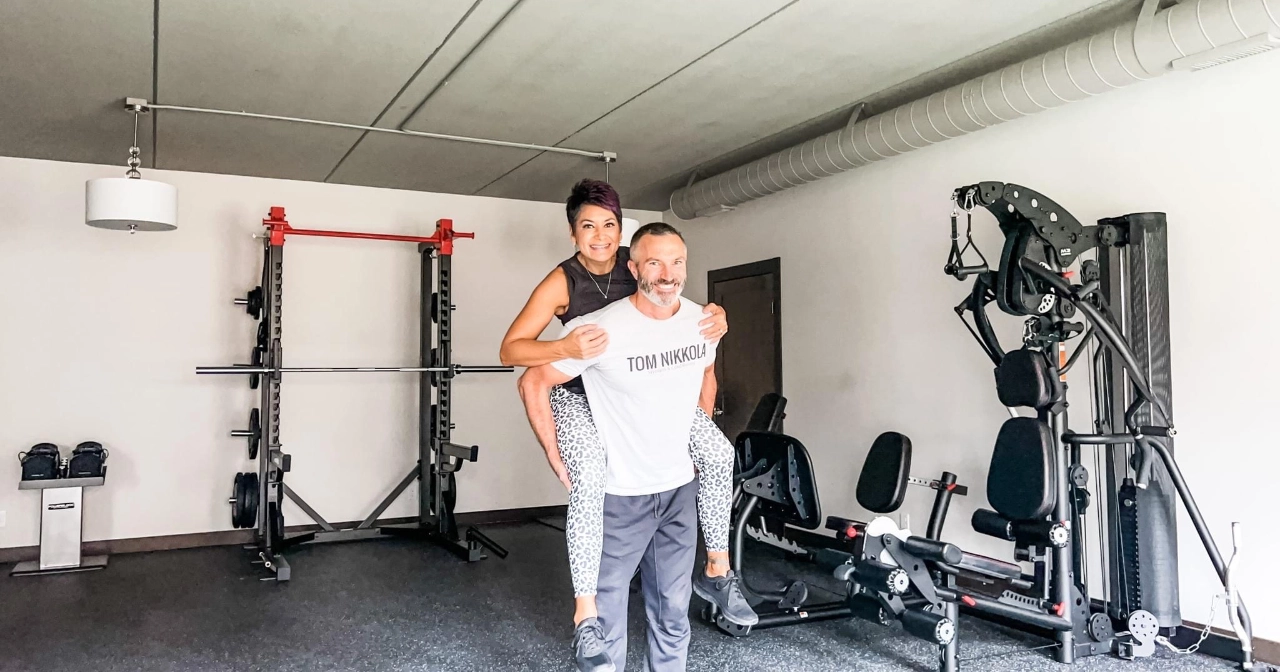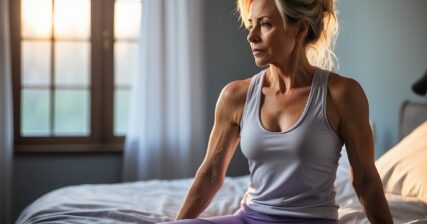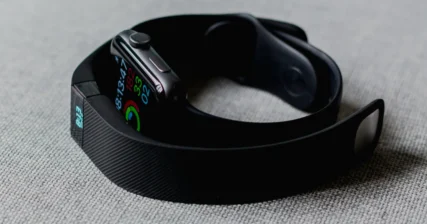Listen on: Apple Podcasts | Spotify
You’re ready to build a home gym, but where do you begin? Which equipment do you need? What brands should you consider? Can you even get as good of a workout at home as you would in a commercial gym? And how much should you expect it to cost?
Vanessa and I recently turned our lower-level family room into a home gym. Even though I had a good idea of what we’d need, sorting through all the equipment options and brands proved more difficult than I thought it would be.
If you find yourself in a similar circumstance, remember this: Home gym companies want you to buy their equipment and make it work for your workouts. It’s like a contractor building the most profitable house to sell you and then trying to convince you that their house is just what your lifestyle needs.
In this guide, we start with your workouts first. Then, I’ll walk you through the right equipment to buy to get the best workouts with the least equipment.
One other point I need to stress: If your home gym equipment isn’t good enough to replace your commercial gym workouts, you’ll end up still going to the gym. If that’s the case, then the investment in your home gym won’t be worth it. Your home gym setup has to be good enough to replace the commercial gym.
That’s where I’ll begin with this guide.
What exercises are essential in a good strength and conditioning program?
If you’re going to make the significant investment in home gym equipment, especially if you’re middle-aged or older, you need equipment that allows you to do at least the following:
Free weight movements (Barbells and Dumbbells)
- Squats
- Lunges
- Chest Press – Flat, Incline
- Shoulder Press
- Pullup / Chinup
- Dips
- Rows
- Deadlifts
Machine movements
- Leg Press
- Leg Extension
- Leg Curl
- Pulldown
- Row
Why do you need free weights and machines? My Crossfit buddy said you only need free weights…I can imagine some who read the list above thinking something along those lines.
First, as you get older, you will develop aches and pains and end up with injured joints. That’s just part of being an active adult. If your only option for hitting your legs hard is to do squats, you won’t have much to do when you hurt your back, helping a friend move some furniture. Having the leg press available ensures you keep up with your lower body training.
Second, movements like extensions and curls have a place in a good strength and conditioning program. They’re often dismissed amongst the free weight purists, but if you want to maximize muscle as you age, as well as ensure your joints have the most protection, you’ll include leg curls and extensions for your legs just as you’d include bicep curls and triceps pressdowns for your arms.
Third, not everyone can do pull-ups, and even if they can, they might not be able to do very many reps. Also, over time, relying only on pull-ups for your back can lead to issues with your elbows and forearms. Don’t get me wrong, pull-ups are a crucial part of a good program, but they’re not the only way you should work your lats. Having a pulldown and row machine available allows you to train your back with a little more variety and less stress on your joints.
You might also wonder, “Why wouldn’t you just get a universal gym?” If you’re 80 or older, a single, multi-exercise piece of equipment could suffice. But machines do not replace the balance and stability benefits of free weights, nor do they allow you to move through a more natural range of motion, which is important for developing posture and joint integrity. On the flip side, there are some things machines can do that free weights can’t. Including both in your home gym, within a reasonable space and cost, is best.
In Search of the Ideal Equipment Setup
With the above in mind, I started searching for just the right solution.
I looked at a Rogue Monster Cave and got pretty close to ordering it. It would have covered all the bases above except the leg press, leg extension, and leg curl. The full Monster Cave was pretty expensive on its own and adding a leg press machine and an extension and curl was more money than I wanted to spend.
Other companies offered “all-in-one” options as well, but the brands weren’t familiar, or there were so many parts that needed adjusting for different exercises that I thought it would get frustrating to work with. Especially if I wanted to train a select group of one-on-one clients.
I looked at big commercial equipment brands like Hammer Strength, LifeFitness, Iron Grip, TechnoGym, and Eleiko. If I had unlimited space and funds, I’d just pick out my favorite pieces at Life Time and order them for my home gym. That’s not a luxury most of us can afford.
I realized I was wasting a lot of time and decided that a better approach would be to start with a list of what I thought was essential equipment for a home gym. Then, I could start comparing what was available for those specific pieces of equipment.
Essential Home Gym Equipment
You might beleive that what I consider “essential” home gym equipment, and what you would, would be different. They shouldn’t be. It doesn’t matter if your current goals are weight loss, recovery from an injury, or to just be generally fit and healthy as you age.
Strength training forms the foundation of programming for any of those goals.
Here’s the essential list of equipment for a great home gym. As I go into detail on each of them, I’ll share which specific product we purchased to cover the list below.
- Power Rack
- Barbell and plates
- Dumbbells
- Adjustable bench
- Leg Curl and Extension
- Pulldown and Low Row
- Leg Press
Power Rack
A power rack allows you to safely perform the majority of barbell exercises, even when you’re working out alone. The safety arms allow you to squat and bench press without needing a spotter.
You can find a basic squat rack for very little money, and you can squat and bench inside it. However, a power rack usually has features built into it that allow you to do other exercises. It often includes a built-in pull-up bar (or multiple pullup bars), a landmine attachment, hooks for adding bands, hooks and horns for hanging your bars and plates, and more.
Higher-priced power racks include extra features, but they’re also built to handle more wear and tear.
After sorting through all the options, we bought the Inspire Fitness Commerical Half Rack, in part because it checked all the boxes I had, and also because it matched another big piece we purchased from Inspire.
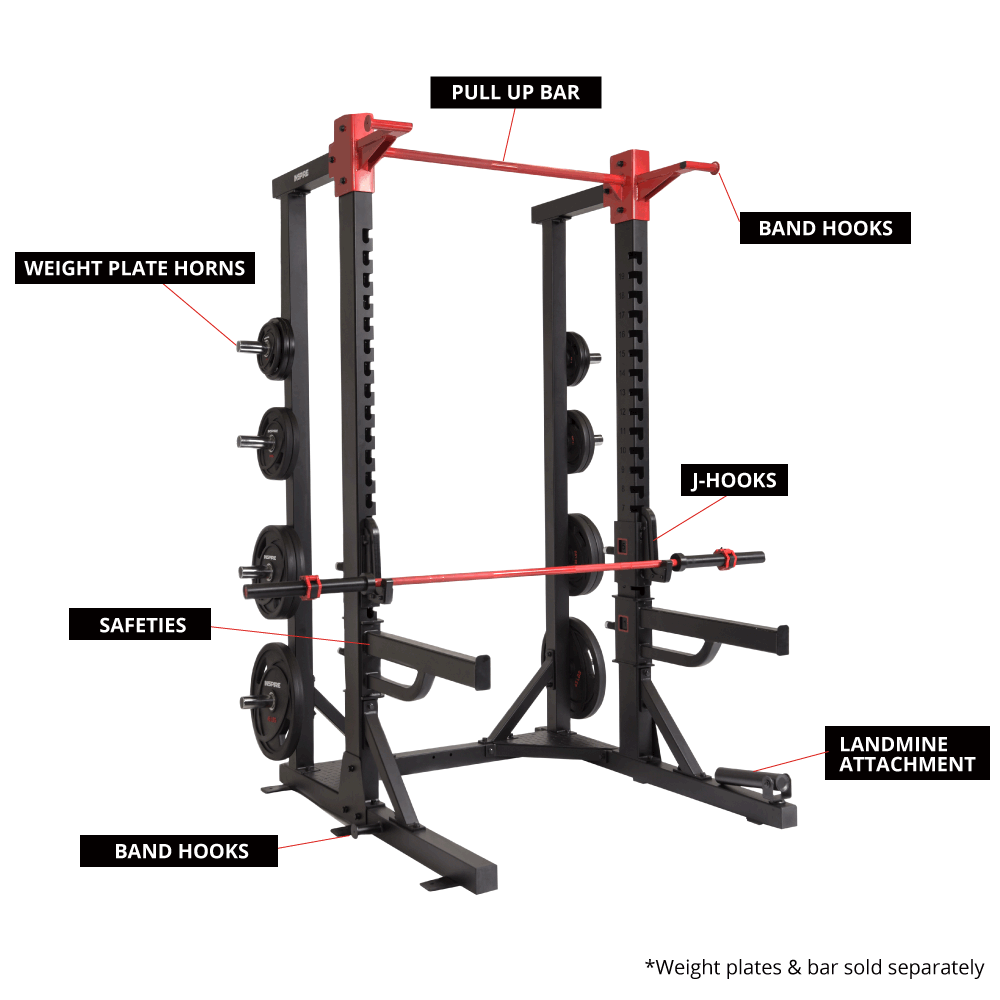
It includes a pullup bar across the top. If you don’t have the upper body strength to do a pullup yet, the band attachments on the ends allow you to hang a resistance band from the top. You can stand on the band, which gives your upper body some assistance for your pull-ups. The base includes band hooks as well, which can be used to add a different type of resistance than free weights alone.
For space-saving, I strongly recommend getting a power rack with plate storage built in. If you don’t, you’ll need to store your weights on a separate rack, taking up valuable floor or wall space.
A landmine attachment on the base allows you to fix one end of a barbell in place so you can add many more forms of pulls, presses, squats, and core exercises. It takes up almost no extra space and adds more variety to your training options.
The final requirement, in my mind, is that it includes a dip attachment. Dips are a must in a serious strength and conditioning program. You could rig up a couple of high-top chairs or parallel bars, but since we’re trying to maximize space and function, buy a power rack with the dip attachment as an option if not included.
The safety bars and J-hooks move up and down the rack based on the height you need for the exercise you’re performing.
To summarize, look for a power rack that includes the following as a minimum requirement:
- Plate storage
- Pullup bar
- Band hooks above and below
- Landmine attachment
- Dip attachment optional, if not included
- Nice to have: Hooks to hang barbells. The rack we bought has a hook on each side, so you can hang your barbells vertically when not in use.
With the above list in mind as a minimum starting point, you’ll find various brands and prices. The more you’re willing to spend, the more features you might find beyond those listed above. We decided on the rack above based on its commercial-level quality and still reasonable price for a home gym piece of equipment.
Adjustable Bench
An adjustable bench allows you to set the back at various angles from horizontal to almost, if not vertical. Some have one setting below horizontal, so you can do movements like declined chest presses or sit-ups. Some include optional attachments on the foot end for preacher curls or leg extensions or leg curls.
Cheap benches feel wobbly when you use them. Avoid wobbly benches. From there, try out the bench before you buy it. It doesn’t need to be a bench that suits the masses, like those in a commercial fitness center. It just needs to fit you and your family.
Since we were buying other Inspire Fitness equipment, we bought their SCS Weight Bench.
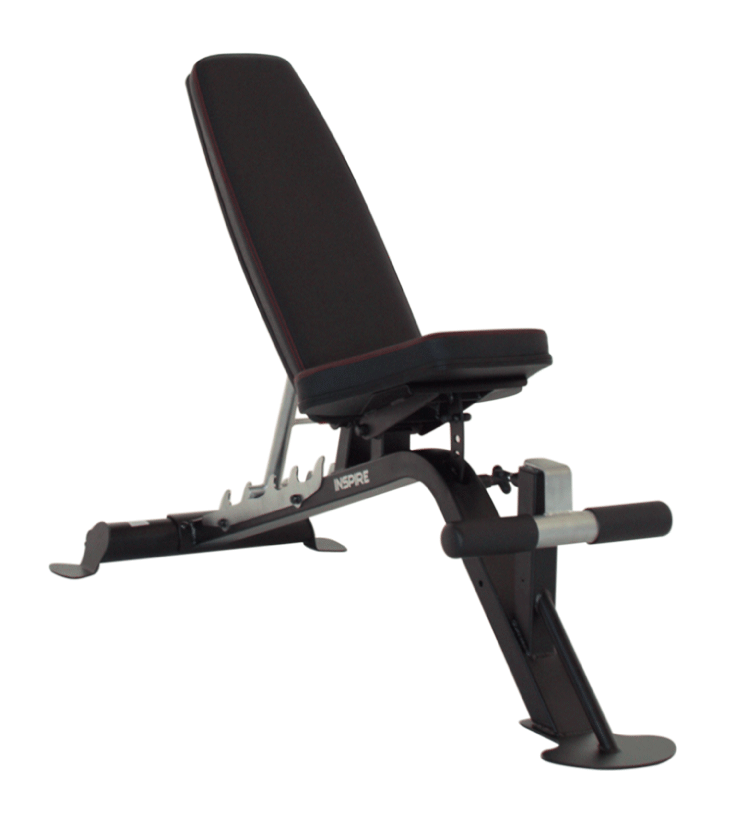
That said, I was pleasantly surprised with one feature on it. It has an adjustable bar on the foot end to hold your feet in place. It works well for Nordic Hamstring Curls, a good alternative for the glute-ham raise since most people won’t have a stand-alone glute-ham raise bench in their home gym.
Barbell and Plates
Like anything, not all bars or plates are the same in terms of quality. For home use, you want something that can handle the load you’re going to put on it, but at the same time, you don’t need to spend money on bars designed for loads you’ll never lift.
For most people, a bar that can handle at least 500 pounds is enough. If you’re not going to be doing a lot of Olympic lifts, you don’t need to worry as much about how the bar rotates or whips. You need a bar with enough gnarling (that’s the rough part of the bar) to maintain a good grip and a thickness that feels good in your hands. Most barbells are 28-32 mm in diameter. If you have big hands, you might like a thicker bar. They should weigh in at 20 kgs, or 44 pounds (for tracking, I always round up to 45 pounds).
As for the plates, I recommend something easy to handle, meaning the plate has a grip built into it. Bumper plates are nice for exercises like deadlifts, as they help keep the noise to a minimum if you need to set the bar down suddenly, but they can also get pretty expensive.
We decided on a TKO economy barbell and the TKO Olympic Rubber Grip plates. The plates are easy to handle and are wrapped in a non-odor rubber. That’s something that could catch you off-guard if you buy a very low-priced set of plates. The rubber could smell up your home.
I love how they look as well as how they feel in my hands when I’m loading and unloading the bar.
Dumbbells
If we had unlimited funds, I would have ordered Eleiko Evo rotating dumbbells. My friend, the late Charles Poliquin, had a full set in his downstairs gym. I couldn’t believe how much of a difference they made in how an exercise felt compared to other dumbbells. Unfortunately, a set from 5-100 lbs. costs about $15,000 before delivery. They’re awesome but well outside our budget.
The other thing to consider is space. A full rack of dumbbells from 5-75 lbs. takes up a lot of space.
We ordered a pair of Powerblock Pros with expansion kits up to 90 lbs. I wasn’t certain I’d love them when we placed our order, but now that I’ve used them for multiple workouts, I can honestly say, “I love them.” Powerblocks are a single pair of dumbbells with a quick-to-adjust clamp that allows you to change your weight from 10 pounds to 90 pounds in seconds. Though they’re square, not round, they feel very similar to regular dumbbells when you use them, and they take up very little floor space when you store them on the Powerblocks stand.
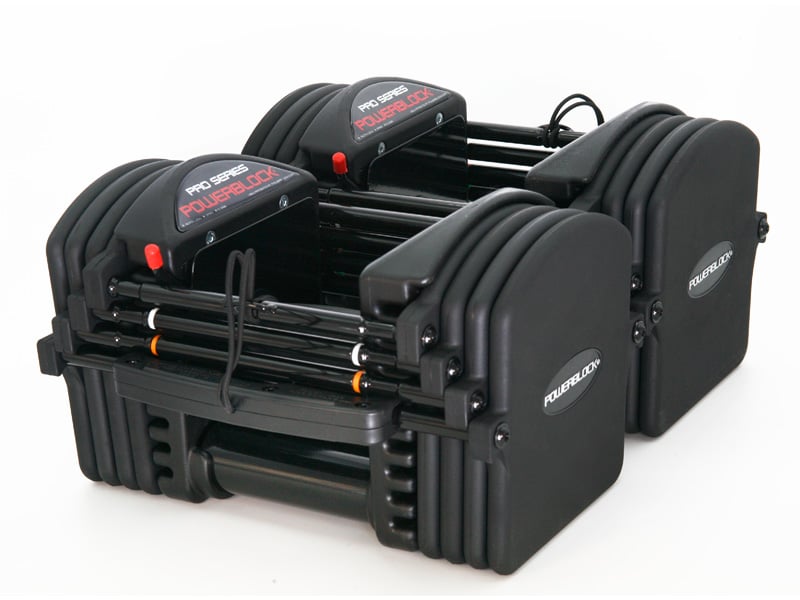
If you have the space and spending money, by all means, buy a full set of dumbbells. If not, you won’t be disappointed by the Powerblocks.
Machine-Based Exercises: Pulldown, Row, Leg Extension, Leg Curl, Leg Press
You’ll find numerous pulldown / low row machines, leg curl/extension machines, and stand-alone leg presses, but surprisingly very few high-quality, multi-exercise machines with each of those exercises included.
While shopping with our grandson Asher one day, we looked at one such unit by Hoist. It had a leg press, extension, curl, chest press, row, pulldown, and a high-low pulley.
The following weekend, Vanessa and I stopped into Push Pedal Pull, a residential and commercial equipment supplier. There, we saw the Inspire Fitness M3, a multi-exercise unit that included all of the machine-based options we were looking for, including an optional leg press add-on.
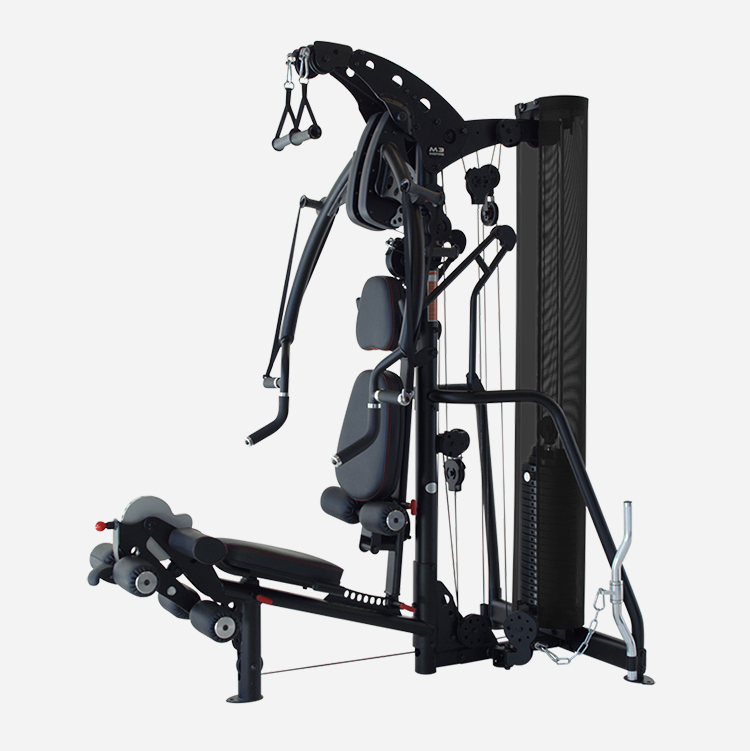
We bought everything through Push Pedal Pull – the free weights, Powerblocks, power rack, M3 Home Gym with the leg press add-on, a True treadmill, and even the rubber flooring tiles. We might have saved a little money here and there by ordering everything separately from the lowest-priced sources, but it didn’t seem like the savings would be worth the headaches. Vanessa and I replaced our carpet with the tiles, and Push Pedal Pull delivered and assembled everything for us. If there are any issues with the equipment, they’ll service it, too. That offers a piece of mind you won’t get from buying everything on your own.
Our Before and After
Here’s how our home gym project turned out. At the time of these photos, we were still planning to add some mirrors to the walls and were waiting on a local carpet company to complete the transition between the rubber tiles and remaining carpet.
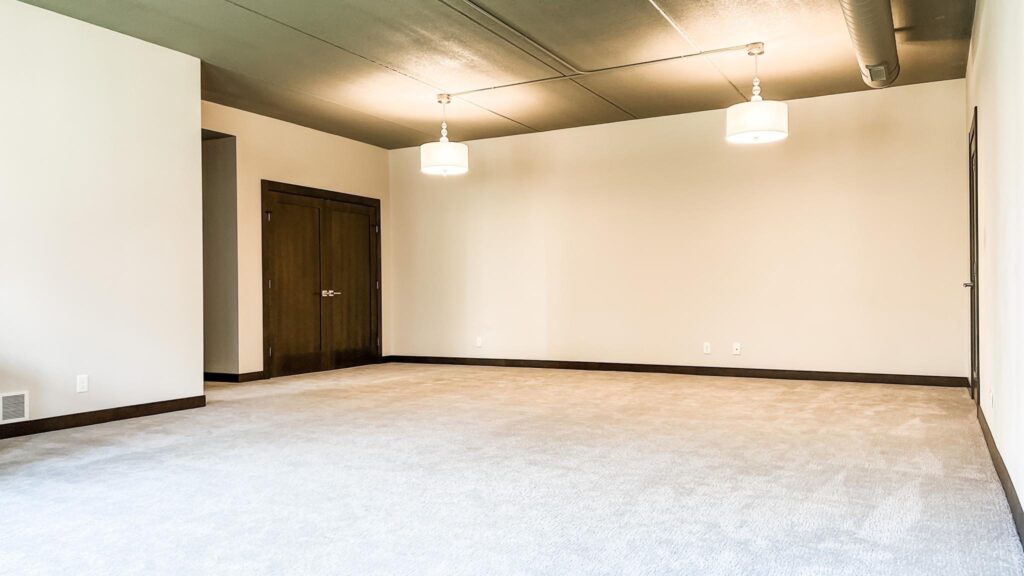
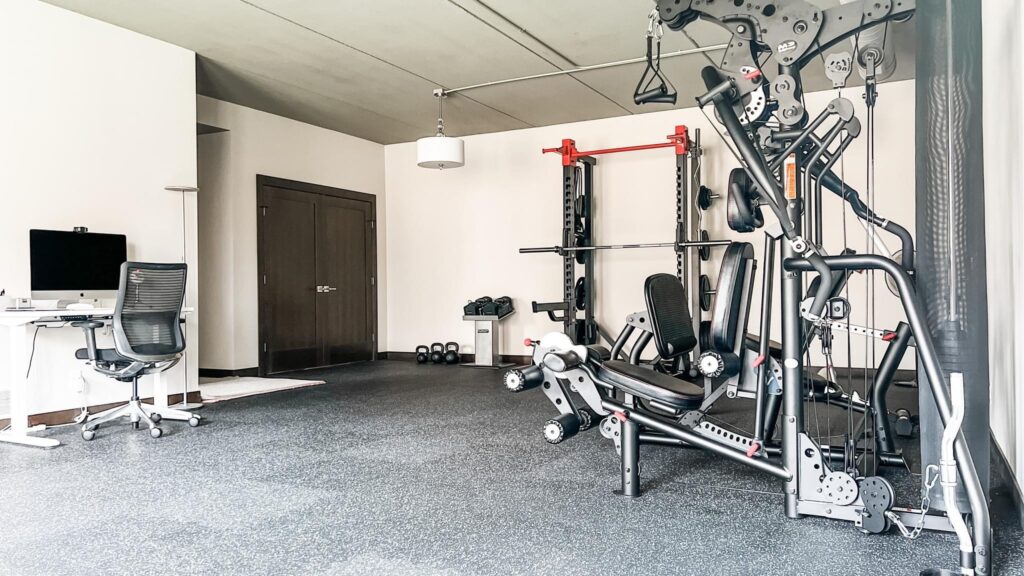
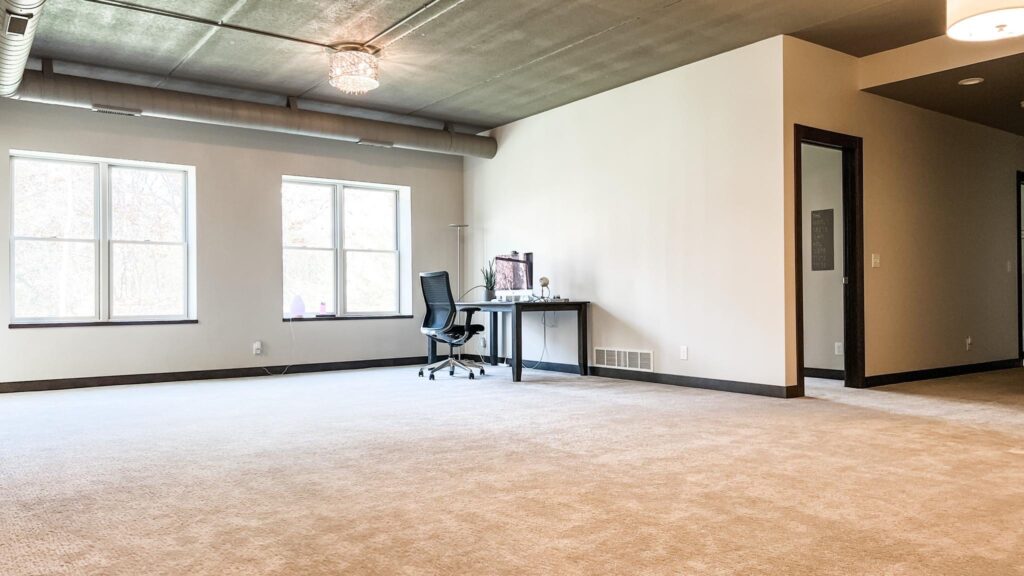

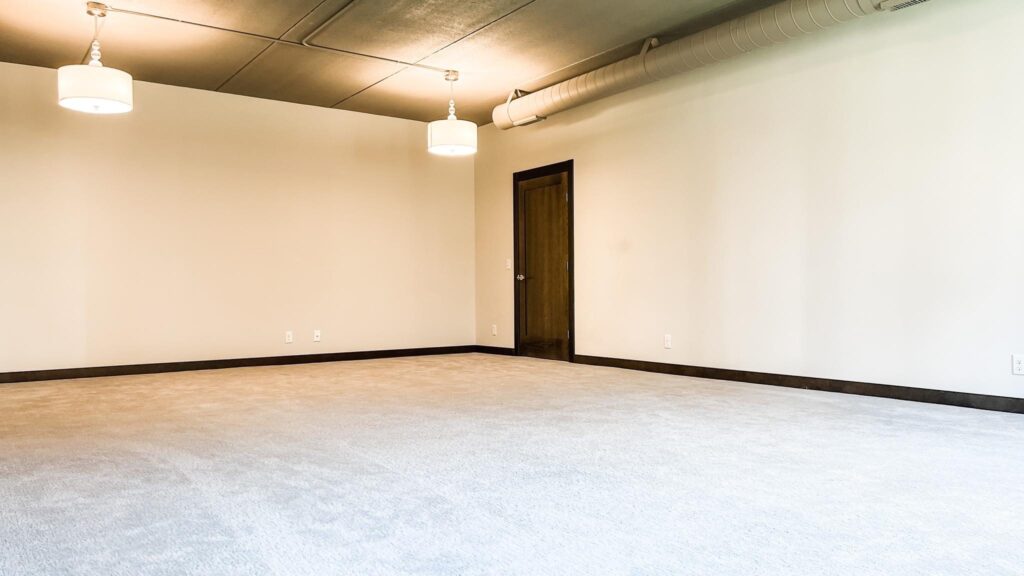
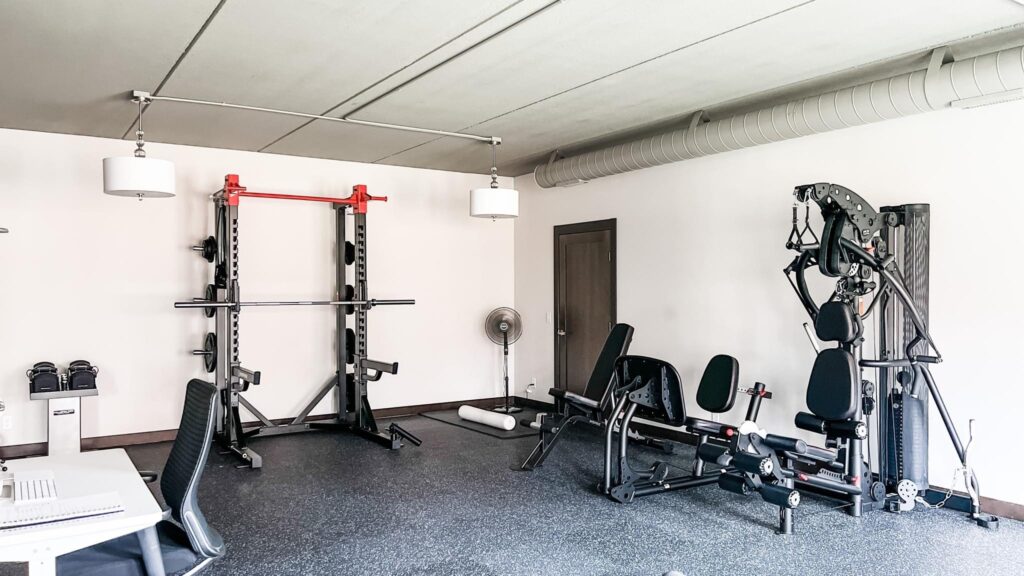
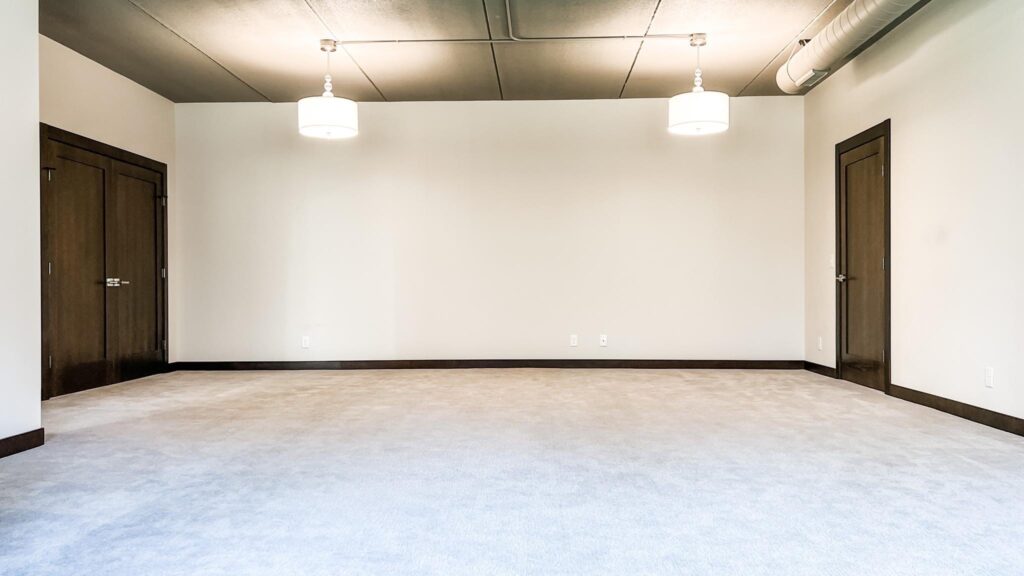
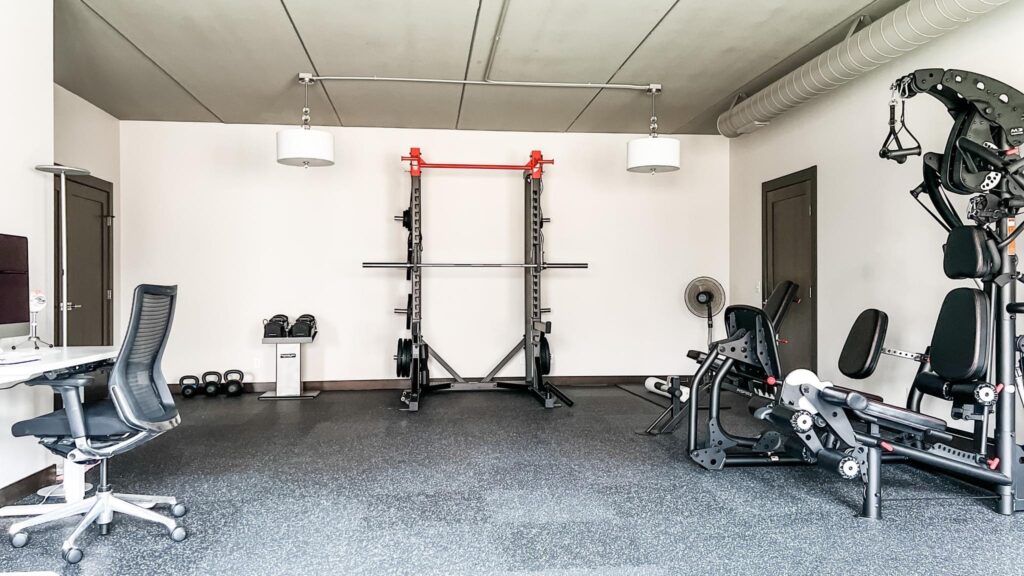
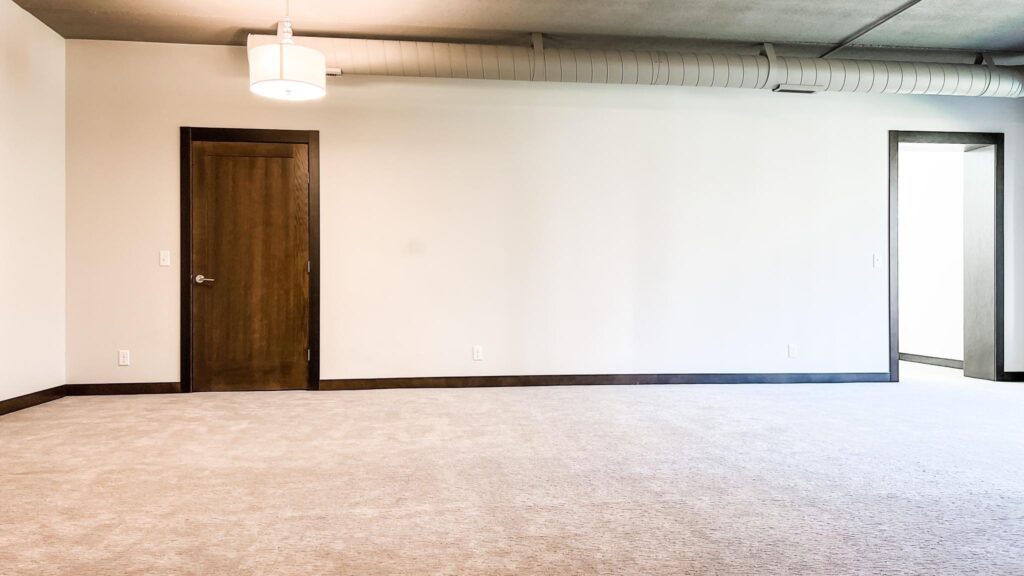
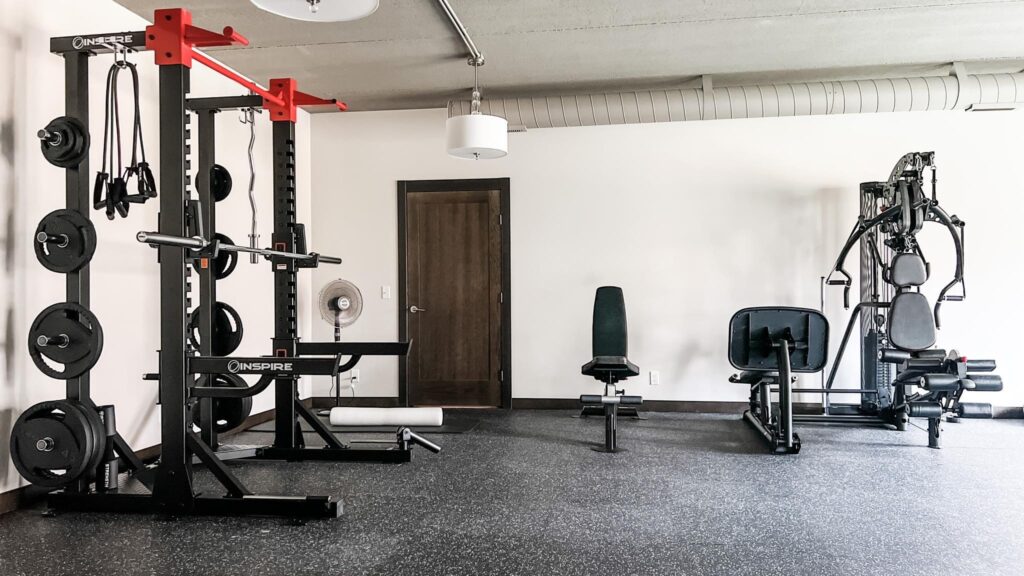
Am I missing something?
What I’ve outlined above gives you a solid foundation for your home gym. You might add little things like bands, plyo boxes, or exercise mats. But you’d have everything you need for consistent, high-quality strength and conditioning workouts, including a variety of exercises to keep you from getting bored or hitting a plateau.
You’d have everything you need to follow one of my strength and conditioning programs.
We do have room for one more large piece of equipment, but I think we’ll save that space for a future infrared sauna instead. After all that exercise, we might as well have something that helps us speed up the recovery process.
I hope this helps you build your perfect home gym. If you have other questions about the products we purchased or how to fit what you need into the space you have, email me. I’m happy to offer some insights.
